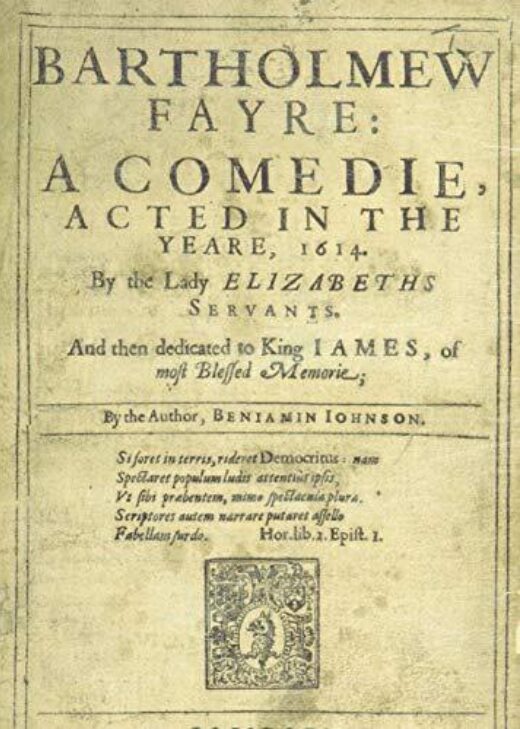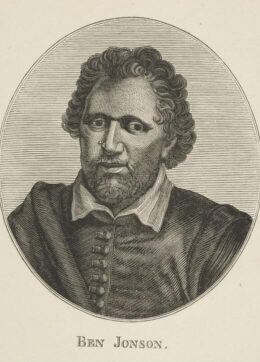
Printed
141 pages
Author(s)
Bartholomew Fair
If the fifth act of Bartholomew Fair contains what is probably the best-known and most-studied puppet play from the reign of James I (1626-1633), this is due to a lack of precise information on the performances of this period. Indeed, while many contemporary documents refer to puppets, attesting to their strong presence both in London and in more rural areas, very little information on the shows they represented has come down to us. Even the animation techniques which were used are difficult to identify. We know nothing, for example, of the puppets Ben Jonson had in mind when he wrote Bartholomew Fair’s play-within-a-play.
Critics tend to believe that Jonson imagined glove puppets, and some stagings, such as the 1950 reconstruction at the Old Vic Theatre in London, opted for this type of puppets. There is no evidence of their use in this play, however. The mythological subject matter of the play-within-a-play and the dialogues written in verse might suggest the use of rod puppets.
Bartholomew Fair does, however, inform us on the fundamental role of the actor, who acted as an intermediate between the audience and the show in the 17th and 18th centuries. This role as a spokesperson, the remains of a time when silent shows were commented on by a showman, is embodied here by puppet-master Lantern Leatherhead. He finds himself confronted by Busy, a character who embodies puritanical thinking but who also reminds us that the audience easily took part in the shows they attended as they would interrupt the action to express their point of view.
According to Helen Ostovich, who recently edited some of Ben Jonson’s comedies (Longman, 1997), the puppet play in Bartholomew Fair also has a parodic function as it allows the playwright to mock Christopher Marlowe’s Hero and Leander, completed by George Chapman in 1598, as well as Richard Edwardes’ Excellent Comedy of Two the Most Faithfullest Friends (1565 and 1571), from which the characters of Damon and Pythias are taken.
London’s Bartholomew Fair dates back from the 12th century. It was the venue for many shows, including several puppet-shows.
A puppet ridicules an enemy of the theatre
Quarlous and Winwife visit the office of their friend John Littlewit, a legal clerk. Both men want to marry Littlewit's mother, Lady Purecraft. They argue over which of them has the better chance of winning her heart. They are joined by other characters, including Bartholomew Cokes, who has come to collect a license to marry Grace Welborn. Littlewit invites the characters to come to the Bartholomew Fair to see the puppet show he has put on. Adam Overdo, a judge and Grace Welborn’s guardian, decides to disguise himself in order to uncover all the crimes committed during the fair.
The plot shifts to the popular world of the Smithfield district, and Littlewit’s group soon finds itself confronted with the debauchery of the fair: Overdo is tricked by Mooncalf, a waitress, and Edgworth, a thief. Edgworth then steals money from Bartholomew Cokes. Overdo, in disguise, is suspected of being the thief’s accomplice. Quarlous and Winwife discover that the culprit is none other than Edgworth, and Quarlous hires him to steal Cokes’s marriage license. Overdo, Wasp (a servant of Cokes who caused a brawl) and the false preacher Zeal-of-the-Land Busy are sentenced to the gallows, while Win Littlewit and Mistress Overdo are encouraged to drink to excess. Trouble-All, a madman, has a fit of madness because no arrest warrant has been issued for Overdo, Wasp and Busy. His outburst creates a diversion and the three men manage to escape from their sentence.
All the characters go to John Littlewit's puppet show, which brings together the love story of Hero and Leander and the friendship of Damon and Pythias. Zeal-of-the-Land Busy constantly interrupts the show to denounce its immoral and blasphemous nature. Puppet Dionysus puts an end to the debate by pulling up its costume, reminding Busy that puppets have no sex: its status as an "object" prompts Busy to change his mind, transforming him into a model spectator.
First performance
Hope Theatre, performed by the Lady Elizabeth's Servants
Publications and translations
Bartholomew Fair: A Comedy. London: John Beale for Robert Allot, 1631.
Ben Jonson: Four Comedies. London: Longman, 1997, p. 541-688.
La Foire de la Saint-Barthélemy, trad. Antoine Maillet. Montréal: Leméac, 1994.
(French)
